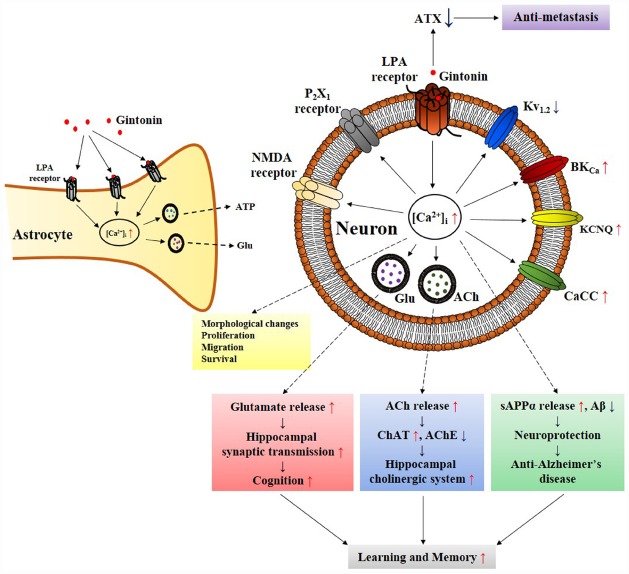FIGURE 2.
Schematic diagram that gintonin-mediated in vitro cellular effects through LPA receptors in neurons and astrocytes is linked to in vivo pharmacological effects. The primary action of gintonin produces second messenger Ca2+ via LPA receptor activations and regulates Ca2+-dependent to various ion channels and receptors regulations, and glio-transmitter and neuro-transmitter release. The ensuing inter-cellular communications via the released neurotransmitters (i.e., acetylcholine or glutamate) can be related to the pharmacological effects that can finally be linked to improvement of learning and memory in nervous system (Kim et al., 2015c). Gintonin also exhibits pharmacological effect against Alzheimer’s disease by attenuating β-amyloid plaque formation and by ameliorating cognitive dysfunction via the activation of non-amyloidogenic pathway and by restoring cholinergic systems that were damaged by β-amyloid in transgenic Alzheimer’s disease animal model (Hwang et al., 2012; Kim et al., 2015b). In astrocytes, gintonin-mediated ATP and glutamate release can be coupled to regulations of neuronal activity (Kim et al., 2015a). In addition, gintonin as exogenous LPA induces various cellular effects such as migration and proliferation of cells as LPAs do through LPA receptor activations. Gintonin also exhibits anti-metastasis activity via inhibition of autotaxin (ATX) activity. ACh, acetylcholine; AChE, acetylcholine esterase; sAPPα, soluble amyloid precursor protein α; ATX, autotaxin; ChAT, choline acetyltransferase; Glu, glutamate.

